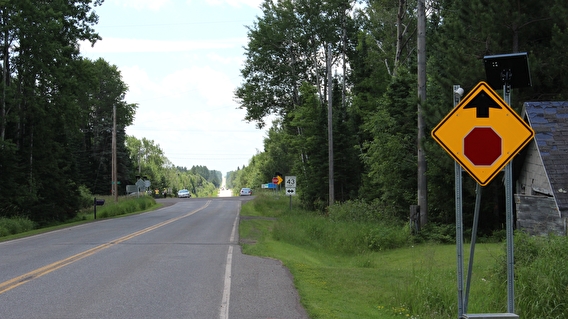
Smart intersection-warning systems may help prevent the most severe crash types at rural intersections, according to a new study by U of M researchers.
Far too often, Minnesota’s rural intersections are deadly for drivers: Crashes at rural two-way-stop intersections make up 65 percent of all the state’s fatal crashes, even though most vehicle crashes happen in urban areas. To address this issue, traffic safety experts have been working on new ways to prevent deadly crashes.
At this type of intersection, a high-volume major road typically intersects with a lower-volume minor road; the major road is uncontrolled while the minor road is controlled by a stop sign. Intersection conflict-warning systems (ICWSs) are a safety measure aimed at reducing right-angle crashes at these intersections.
“Our goal was to analyze before-and-after data to see if the systems were having the intended effect,” says Disi Tian, a current postdoc at the HumanFIRST Laboratory and former doctoral student in the Midwest Center for Occupational Health and Safety (MCOHS) in the School of Public Health. Others on the research team included Professors Susan Gerberich (Tian’s PhD advisor), Hyun Kim (Tian’s PhD co-advisor), and Darin Erickson at the School of Public Health and Nichole Morris, director of the U’s HumanFIRST Laboratory.
Researchers examined 56 Minnesota intersections that had been treated with an ICWS to determine the impacts on crash reduction. They looked at the annual crash rates—per year, per intersection—before and after system activation, comparing the ICWS intersection group with control (non-ICWS) intersection groups. Data for three years before IWCS activation and up to five years after activation was included, ranging from 2010 to 2018.
Data analysis techniques were used to estimate the average, immediate, and continuing treatment effects of ICWSs. Crash outcomes were evaluated in five categories: total, all-injury, non-injury, right angle, and non-right-angle.
“Our results show that ICWS treatment was significantly associated with a decreasing trend for right-angle crash rates—in other words, it looks like ICWSs are doing what they’re supposed to do,” Tian says. “Other types of crashes, such as left-turn crashes that could happen when drivers misjudge the gap between them and oncoming traffic, also decreased with ICWS treatment.”
Although not statistically significant, the study also suggested a possible continuing effect of ICWS treatments for crash reductions, particularly among the more severe injury crashes.
The results provide important insight into potential causal associations between intersection safety countermeasures and crashes at these intersections. “Most importantly, we found ICWS may help prevent right-angle crashes—the most dangerous type,” Tian says. “One possible explanation may be due to the ICWSs’ effectiveness in reducing vehicle speeds on major approaches, as suggested by previous research. This effect could allow more reaction time for drivers on both major and minor roads to modify their approaches and avoid more direct and severe angle impacts during crossing or left turns.”
The research was supported, in part, by the Midwest Center for Occupational Health and Safety, Education and Research Center Pilot Project Research Fund (through the National Institute for Occupational Safety and Health, Centers for Disease Control, and Department of Health and Human Services).
The findings were published in a paper—Evaluation of the efficacy of an intersection conflict warning system at two-way stop-controlled rural intersections: difference-in-differences and triple-difference analytical approaches—in Injury Prevention, 2022, 28: 204–210.
Writer: Megan Tsai


